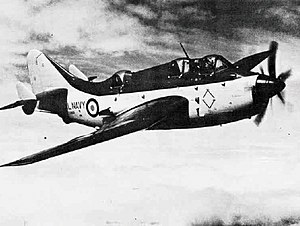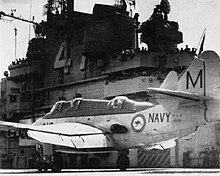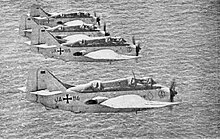
The Fleet Air Arm (FAA) is the naval aviation component of the United Kingdom's Royal Navy (RN). The FAA is one of five RN fighting arms. As of 2023 it is a predominantly "rotary" force, with helicopters undertaking roles once performed by biplanes such as the Fairey Swordfish. It operates the F-35 Lightning II for maritime strike and the AW159 Wildcat and AW101 Merlin for commando and anti-submarine warfare.

The Fairey Swordfish is a biplane torpedo bomber, designed by the Fairey Aviation Company. Originating in the early 1930s, the Swordfish, nicknamed "Stringbag", was principally operated by the Fleet Air Arm of the Royal Navy. It was also used by the Royal Air Force (RAF), as well as several overseas operators, including the Royal Canadian Air Force (RCAF) and the Royal Netherlands Navy. It was initially operated primarily as a fleet attack aircraft. During its later years, the Swordfish was increasingly used as an anti-submarine and training platform. The type was in frontline service throughout the Second World War.

The Supermarine Seafire is a naval version of the Supermarine Spitfire adapted for operation from aircraft carriers. It was analogous in concept to the Hawker Sea Hurricane, a navalised version of the Spitfire's stablemate, the Hawker Hurricane. The name Seafire was derived from the abbreviation of the longer name Sea Spitfire.

The Fairey Barracuda was a British carrier-borne torpedo and dive bomber designed by Fairey Aviation. It was the first aircraft of this type operated by the Royal Navy's Fleet Air Arm (FAA) to be fabricated entirely from metal.

The Grumman TBF Avenger is an American World War II-era torpedo bomber developed initially for the United States Navy and Marine Corps, and eventually used by several air and naval aviation services around the world.

The Fairey Fulmar is a British carrier-borne reconnaissance aircraft/fighter aircraft which was developed and manufactured by aircraft company Fairey Aviation. It was named after the northern fulmar, a seabird native to the British Isles. The Fulmar served with the Royal Navy's Fleet Air Arm (FAA) during the Second World War.

The Fairey Albacore is a single-engine biplane torpedo bomber designed and produced by the British aircraft manufacturer Fairey Aviation. It was primarily operated by the Royal Navy Fleet Air Arm (FAA) during the Second World War.

The Fairey Firefly is a Second World War-era carrier-borne fighter aircraft and anti-submarine aircraft that was principally operated by the Fleet Air Arm (FAA). It was developed and built by the British aircraft manufacturer Fairey Aviation Company.

The Grumman F6F Hellcat is an American carrier-based fighter aircraft of World War II. Designed to replace the earlier F4F Wildcat and to counter the Japanese Mitsubishi A6M Zero, it was the United States Navy's dominant fighter in the second half of the Pacific War. In gaining that role, it prevailed over its faster competitor, the Vought F4U Corsair, which initially had problems with visibility and carrier landings.

The Short SB.6 Seamew was a British aircraft designed in 1951 by David Keith-Lucas of Shorts as a lightweight anti-submarine platform to replace the Royal Navy Fleet Air Arm (FAA)'s Grumman Avenger AS 4 with the Reserve branch of the service. It first flew on 23 August 1953, but, due to poor performance coupled with shifting defence doctrine, it never reached service and only 24 production aircraft had flown before the project was cancelled. It has been described as a "camel amongst race-horses".

The Westland Wyvern was a British single-seat carrier-based multi-role strike aircraft built by Westland Aircraft that served in the 1950s, seeing service in the 1956 Suez Crisis. Production Wyverns were powered by a turboprop engine driving large and distinctive contra-rotating propellers, and could carry aerial torpedoes.

The Fairey Aviation Company Fairey III was a family of British reconnaissance biplanes that enjoyed a very long production and service history in both landplane and seaplane variants. First flying on 14 September 1917, examples were still in use during the Second World War.

The Blackburn Shark was a carrier-borne torpedo bomber designed and built by the British aviation manufacturer Blackburn Aircraft. It was originally known as the Blackburn T.S.R., standing for "torpedo-spotter-reconnaissance", in reference to its intended roles. The Shark was the last of Blackburn's biplane torpedo bombers.

849 Naval Air Squadron was a squadron of the Fleet Air Arm, the Air Arm of the British Royal Navy. It was formed during the Second World War as a carrier based torpedo-bomber, unit, flying missions against Japanese targets in the Far East. Its service since the Second World War has been as an airborne early warning squadron, flying fixed winged Skyraiders and Gannets from the Royal Navy's fixed wing carriers from 1952 until 1978, and airborne early warning Sea King helicopters from 1982 to 2018.

The Armstrong Siddeley Double Mamba is a turboprop engine design developed in the late 1940s of around 3,000–4,000 hp (2,200–3,000 kW). It was used mostly on the Fairey Gannet anti-submarine aircraft developed for the Fleet Air Arm of the Royal Navy.
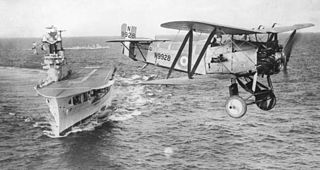
The Fairey Flycatcher was a British single-seat biplane carrier-borne fighter aircraft made by Fairey Aviation Company which served from 1923 to 1934. It was produced with a conventional undercarriage for carrier use, although this could be exchanged for floats for catapult use aboard capital ships.

The Fairey Seal was a British carrier-borne spotter-reconnaissance aircraft, operated in the 1930s. The Seal was derived – like the Gordon – from the IIIF. To enable the Fairey Seal to be launched by catapult from warships, it could be fitted with floats.
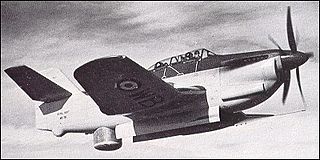
The Blackburn B-54 and B-88 were prototype carrier-borne anti-submarine warfare aircraft of the immediate post-Second World War era developed for the Royal Navy's Fleet Air Arm (FAA). They shared a conventional monoplane design with a mid-mounted inverted-gull wing and tricycle undercarriage. The pilot and observer sat in tandem under a long canopy atop the fuselage. The B-54 had a piston engine while the B-88 had a gas turbine driving large contra-rotating propellers. The radar scanner was mounted in a retractable radome in the rear fuselage, behind a long internal weapons bay. The program was cancelled in favour of the Fairey Gannet aircraft.

The Fairey Gannet AEW.3 is a variant of the Fairey Gannet anti-submarine warfare aircraft intended to be used in the airborne early warning (AEW) role on aircraft carriers of the Royal Navy. It was introduced to service in 1959 to replace the obsolete Douglas Skyraider, and was intended as an interim solution until the planned introduction of a new, purpose built AEW platform for use on the planned CVA-01 aircraft carriers. Neither the new aircraft carriers nor the new AEW aircraft were proceeded with, and the Gannet AEW.3 remained in service until the last aircraft carrier that could operate it was retired in 1978.
